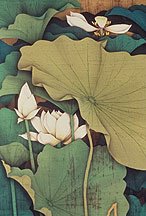Last Chance to See Rozome Exhibit

The Textile Museum's exhibit of Japanese rozome fabrics will end on February 12.
Rozome Masters of Japan features the work of 15 contemporary Japanese artists and includes folding screens, scrolls, panels and kimono, all created using rozome, a wax-resist dyeing technique unique to Japan. The exhibition is complemented by a selection of Japanese textiles from The Textile Museum’s own collections.
Rozome has its roots in ancient Japan, dating to the Nara period (645-794), but was eclipsed by other resist-dye techniques after the Heian period (794-1185). The technique experienced a revival of popularity in the early part of the 20th century, when Kyoto-based kimono specialists began to reexamine the possibilities of the wax-resist medium.
Rozome flourished after World War II as artists became interested in the technique as a vehicle for unique image-making and self-expression on cloth. Today, in the hands of these talented artists, rozome is used to create technically breathtaking, complex works whose imagery ranges from traditional botanical and landscape subjects to contemporary abstract compositions.
Admission is free. The Textile Museum is located at 232o S Street, NW.

<< Home